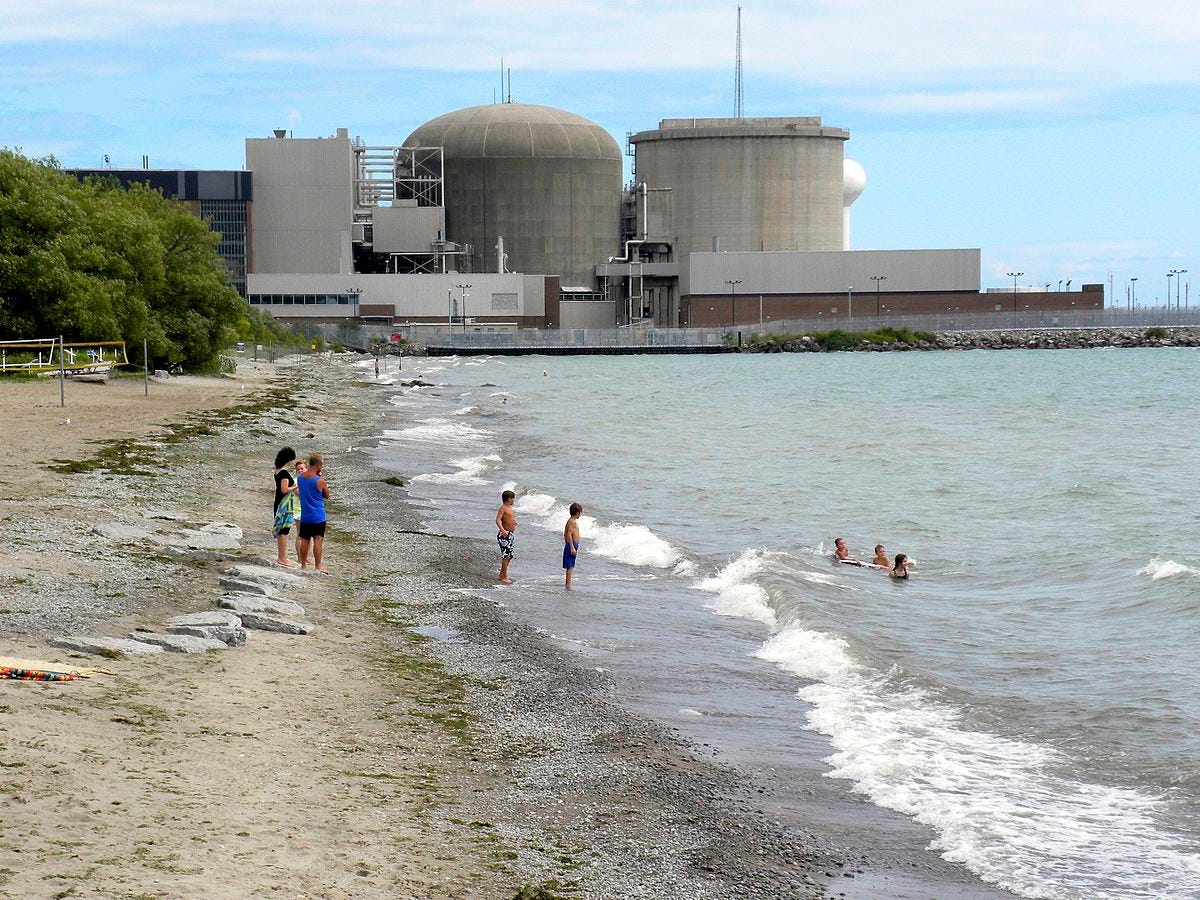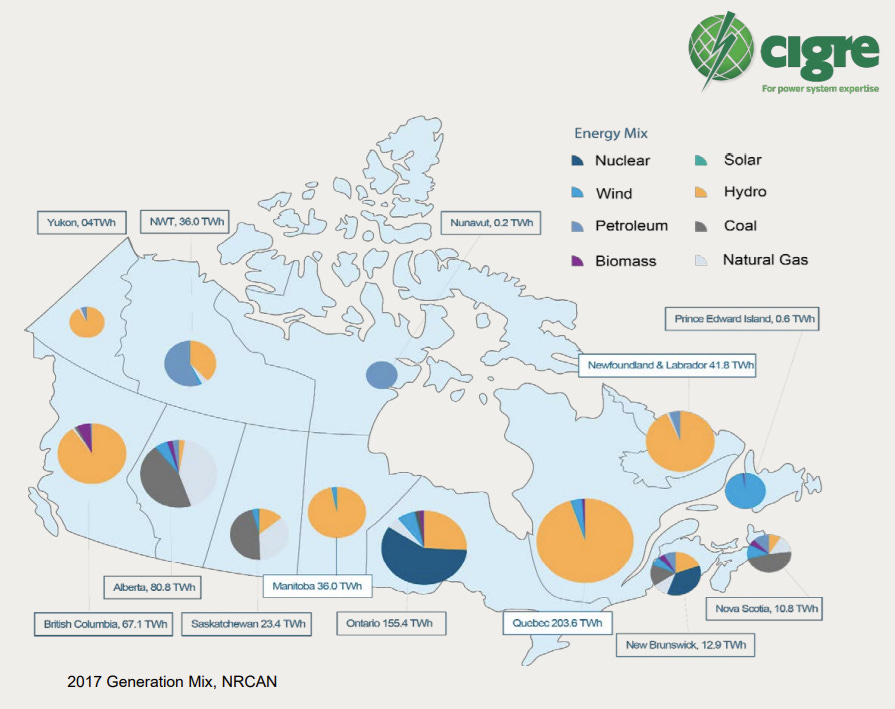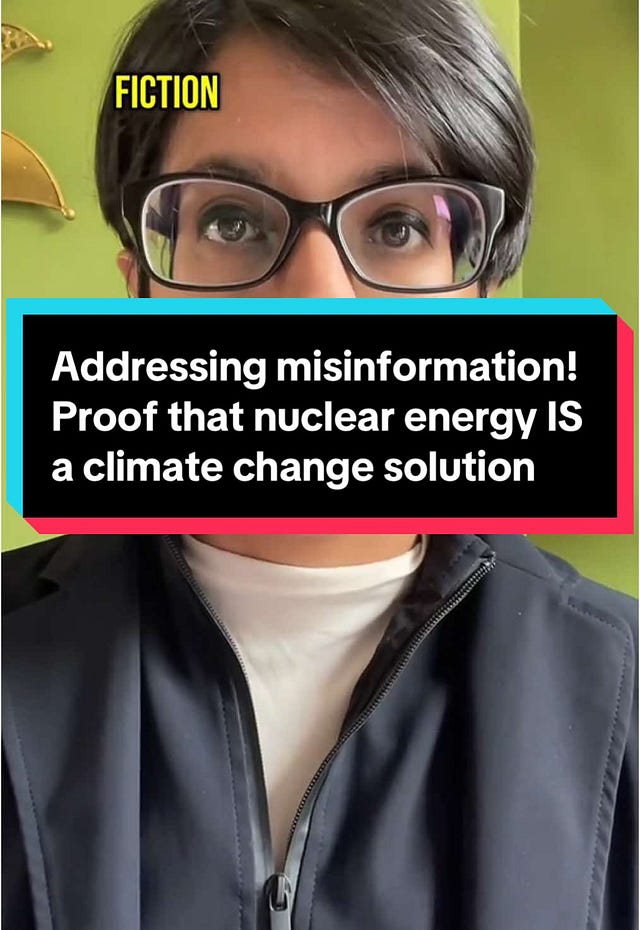The battle for Canada's clean energy future
Nuclear made Ontario green. So why is Canada still stuck debating hydro vs. hydrocarbons?

There’s a lot going on in Canada.
If you look at the headlines, Canada appears to be crushing the clean energy transition. The country already gets over 80% of its electricity from non-emitting sources, mostly hydropower. That’s a higher share than Germany, the UK, or the US. But take a closer look, and the cracks begin to show.
Due to drought and extreme weather, Canada’s hydroelectric output fell significantly in 2023, contributing to a 3.9% drop in total electricity generation. In British Columbia, a province typically rich in hydropower, reservoir levels fell sharply, forcing a major shift in energy sourcing. BC Hydro had to import approximately 13,600 GWh of electricity - about 25% of the province’s needs - at a cost nearing $1.4 billion. To meet demand, gas-fired power plants were also activated, and imports flowed in from Alberta and US states. The situation marked a dramatic change for a province historically known for clean, surplus electricity.
Why does this matter? Because hydropower has long been considered the gold standard of reliable renewables - clean, steady, abundant. But if that’s no longer true because climate stress is making even hydro unpredictable, then building your entire grid around it starts to look a lot less clever.
Managing a grid requires balance. While diversity in energy sources is valuable for resilience and sustainability, it’s equally crucial to ensure that those sources are well-connected and coordinated. Without proper integration and communication across the grid, even the best mix of generation can lead to instability, inefficiencies, or blackouts.

Canada has an unusual energy problem: many resources, but no unified grid. Instead, it’s a patchwork of provincial fiefdoms, with each running its own electricity system with wildly different priorities. Quebec and BC are hydro-heavy. Ontario champions nuclear. Alberta and Saskatchewan still burn a lot of fossil fuels. There's no real national coordination, just a loose quilt of policies stitched together across time zones. That might have been fine when things were stable, but in an era of climate shocks and surging electrification, it’s starting to look less like diversity, and more like a liability.
In reality, Canada is not one energy nation, but two. One runs on clean power like hydro and nuclear. The other still burns a lot of fossil fuels. And problems arise because they barely talk to each other. Interprovincial transmission is limited, so when one province is flush with clean energy and another is scrambling to keep the lights on with gas, there’s no real way to share. That means when the lights flicker in one part of the country, the others have to just sit back and watch, even if they want to help.
In 2024, CBC news reported the following, while simultaneously arguing for more renewables:
“On Saturday evening, amid extreme cold temperatures near -40 C in most of Alberta, residents received an emergency alert asking them to reduce power use or risk rolling blackouts…Meanwhile, there was next to no wind blowing, so the province's wind farms weren't generating power, and solar plants weren't operating after dark.”
And:
“Alberta's grid is "uniquely islanded,"...with only three connections to B.C., one to Saskatchewan and one to Montana, all of them with relatively low capacities…To make matters worse, when Alberta's alert was issued, B.C. was unable to provide power as it was "in the same boat" with its own extreme cold snap.”
As I’ve mentioned before, mainstream media reporting on energy is part of the problem.
News outlets push for variable renewables like wind and solar to be added at warp speed, but they don’t consider or necessarily understand the amount of infrastructure that is needed to support them. And unlike big spinning machines in hydro and nuclear plants, these inverter-based resources don’t provide physical inertia - the natural buffer that helps grids stay stable when something suddenly goes sideways. Inertia buys you milliseconds to react before cascading failures kick in. Spain learned that the hard way in April, when a midday voltage spike, just as solar generation was peaking, triggered a rapid-fire disconnection of plants and a complete blackout across the Iberian Peninsula.
Read my post on the Iberian blackout:
The silliest part of all this is that Canada already has the answer. It invented one of the best reactors in the world, and Ontario quietly showed how to crack the clean energy puzzle two decades ago. While Germany was spending hundreds of billions on solar panels and wind turbines and shutting down perfectly good nuclear reactors, Ontario leaned into nuclear, and used the stable, low-carbon power source to phase out coal entirely. As usual, this doesn’t get nearly as much media attention as the German’s energy transition does, because it doesn’t fit the mainstream narrative that it has to be achieved with renewables.
Yet as of 2019, nearly 94% of Ontario’s electricity was emissions-free, with nuclear accounting for roughly 61% and hydro around 25%. In contrast, Germany’s energy pivot involved phasing out nuclear entirely by 2023, boosting solar and wind, and ramping up reliance on coal and gas instead. This is a story worth telling.
What’s so good about this Canadian reactor? The CANDU reactor (short for CANada Deuterium Uranium) is arguably one of the most underrated feats of Canadian engineering. It was developed in the 1950s and 60s by Canadian scientists and engineers, primarily at the National Research Council of Canada and Atomic Energy of Canada Limited (AECL).
Designed and built entirely in Canada, it broke with global convention by running on natural uranium and using heavy water as a moderator, which means that it doesn’t need expensive uranium enrichment. That independence, along with its remarkable fuel efficiency and ability to be refuelled while running, has made it a powerhouse of reliability. In a world obsessed with flashy energy breakthroughs, Canada already built a genius solution decades ago, and it has been proven to work.
This isn’t just my opinion. Nuclear power plants like Bruce Power and Darlington consistently rank among the world’s best for uptime and output. Operators worldwide praise CANDU’s fuel flexibility, longevity, and safety record. These reactors have been running safely and reliably for decades, not just at home, but globally. Countries like South Korea, India, China, and Romania have all built and operated CANDU-style reactors. India took the design and built 16 of its own, and just last year, Romania placed an order to double its nuclear capacity with the world’s first new CANDU reactors since 2007. This isn’t experimental tech, but a tried-and-true workhorse that keeps proving its value.

So why isn’t the rest of Canada copying Ontario?
If you guessed “subtle anti-nuclear misinformation,” you’re correct. I did a little digging and discovered the following: Canadian Geographic is a respected source used in classrooms nationwide, with teacher resources including various infographics. This resource for schools incorrectly ranks nuclear energy as more polluting than renewables. It places nuclear just above, but essentially grouped with, fossil fuels, which is flat-out wrong, since according to rigorous data from bodies like the UN Economic Commission for Europe (UNECE) and Our World in Data, nuclear energy is actually cleaner than some renewables, notably solar power. And that’s before we talk about other environmental impacts like land use and mined resources. This kind of misleading messaging matters because it comes from a highly trusted organisation, and shapes how future generations understand the energy transition.
When the education system itself spreads misinformation like this, it’s no wonder that Canada has drifted away from nuclear energy, and why many influencers keep pushing the same anti-nuclear narratives.
So, somewhat predictably, nuclear is politically contentious in most Canadian provinces. In Alberta, political leaders and policymakers continue to openly oppose introducing nuclear energy. Quebec shuttered its only commercial nuclear reactor in 2012, and has since ruled out restarting it, largely due to cost and public opposition. And federal plans for new small modular reactors (SMRs) remain mostly stuck in the “promise” phase.
Watch my video response debunking a famous Canadian influencer on nuclear:

 Tiktok failed to load.
Tiktok failed to load.Enable 3rd party cookies or use another browser
Meanwhile, grid reliability is fast becoming a national headache. With demand surging from electric vehicles, electric heating, and data centres, provinces that are leaning too hard on weather-dependent renewables are basically playing blackout roulette. Without major investments in grid stability, stronger interconnections, and a sober rethink on nuclear energy, Canada’s clean energy transition could come crashing down.
All hope is not lost, as the nuclear resurgence has reached Canada as well. After years of wavering on nuclear, Canada is finally doubling down on its homegrown CANDU reactor technology, and earlier this year, the federal government pledged funds to develop the next-generation CANDU design. But it’s a shame to have to pivot to smaller designs when existing CANDU reactors are Canada’s crown jewel in nuclear tech. Their biggest problem isn’t technical, but political. These reactors pump out steady, low-carbon electricity in provinces like Ontario, while neighbouring regions still burn fossil fuels, because Canada doesn’t have a real national grid. Fix the grid by building the connections, and suddenly, the CANDU problem becomes the CANDU solution.
If Canada is serious about energy security, decarbonisation, and staying competitive in the global energy market, taking this approach is a no-brainer. After all, why import electricity or reinvent the wheel when you already designed one of the best reactors in the world?
If you want to stay ahead of the energy transition, this is your must-read. Subscribe now to get it first.
Already subscribed? Thanks for helping this newsletter grow, and feel free to forward it to one smart friend who cares about the future of reliable clean energy.






Your commentary on electricity in Canada is very good. Your takedown of the so-called ‘influencer’ was very accurate. His statements were so off-the-wall, that I’m not sure who he thought he would influence.
With respect to Canada’s environmental benefit of building nuclear, that was almost entirely by happenstance. The problem was Ontario. From its inception in 1906, Ontario’s electricity system had been entirely hydraulic. However, the massive increase in industry during World War II meant that Ontario’s electricity resources were nearly fully developed and used by about 1940.
So, Ontario had to import coal from the United States to supplement its power supplies. However, this posed severe problems because of the extreme difficulty in transporting coal from the Tennessee Valley to Ontario. The only possible alternative was nuclear power.
This is the same reason that drove nuclear power development in France, Belgium, Sweden, Japan and the eastern United States. No coal.
I agree with all of your conclusions about CANDU. It was arguably the finest nuclear power generating system ever devised for technical reasons. As a result of its construction program, Ontario now has the world’s largest nuclear power generating complex: the eight large reactors of the Bruce nuclear power station in Kincardine. In Ontario, it is only matched by the four large reactors at Darlington. Depending on the time of day, Ontario gets up to 80 per cent of its electricity from nuclear power.
However, all of these reactors were built by a company that no longer exists: the Nuclear Design and Construction Branch of Ontario Hydro. That company was deliberately demolished by the NDP government under Bob Rae in 1993. All of the people who designed and built those nuclear reactors are now all long dead. The companies which built all of the large components of those reactors are also largely dismantled or repurposed.
The good news is that the existing reactors are not going anywhere. All Bruce and Darlington reactors have been refurbished for nominal operations for another 40 years. The same program will be carried out for four of the reactors at Pickering as well. However, Ontario gets about 250,000 immigrants every year. They all consume electricity, so the question now is where will that electricity come from. If there are no new nuclear power plants, that electricity will come from burning natural gas.
One thing this article missed about the seeming “hodgepodge” of energy regimes is the gigantic size of the country itself topographically. The United Kingdom fits into a little less than 2/3 of the fourth biggest province, Alberta.